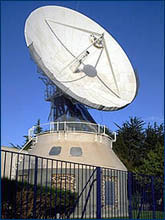The Search for Extraterrestrial Intelligence
Updated February 21, 2017 | Factmonster Staff 

A History of SETI
The search for intelligent life continues in the halls of science
 |
Are we alone in the universe? The question has been asked since people first walked the earth way back when. We may never know, but at least some people other than Fox Mulder and Dana Scully are actively searching for an answer.
The oft-criticized Search for Extraterrestrial Intelligence (SETI) program received a much-needed credibility boost recently with the appointment of a long-time SETI researcher to a chair at the University of California, Berkeley.
Jack Welch, a member of the SETI Institute's Board of Directors, was named to the chair for the Search for Extraterrestrial Intelligence in 1999. The chair, funded by a $500,000 grant from Watson and Marilyn Alberts, gives the SETI project increased standing in the academic world.
Derided by some as a waste of time, SETI has been embraced by others as a noble pursuit since at least 1959, when the modern era of extraterrestrial-seeking began. In that year, two Cornell physicists, Giuseppi Cocconi and Philip Morrison, published an article in the science journal Nature in which they discussed the potential for using microwave radio to communicate with deep space.
In 1960 Frank Drake, a young radio astronomer who reached the same conclusion independently, performed the first microwave radio search for signs of intelligent life in space. While he was unsuccessful, he generated some interest in the field.
The Soviet Union did a lot of SETI work in the 1960s, searching large parts of the sky, without success. In the '70s, Americans began to look again. Efforts that are still underway began in the 1970s, including the Planetary Society's Project META and The University of California's SERENDIP (the Search for Extraterrestrial Radio Emissions from Nearby Developed Intelligent Populations) project.
In 1988, NASA, after a decade of preliminary study, formally adopted a dual-mode strategy for a large-scale SETI project. The program at NASA's Ames Research Center in Mountain View, California, would use an intense, tightly focused search, while a group at the Jet Propulsion Laboratory in Pasadena, California, would make a broader, sweeping sky survey.
Observations began in 1992, the but within a year Congress cut the funding because of budget constraints.
Without government money, the SETI Institute continues its mission with private funding. The institute has undertaken what it calls Project Phoenix, using a Targeted Search approach like the one NASA took at the Ames Research Center.
The strategy is to carefully examine the area around 1,000 nearby (within 200 light years) Sun-like stars using the world's largest antennas. Such stars are deemed most likely to support older planets that could in turn support intelligent life.
Unfortunately, time may be running out. It is estimated that in less than 10 years, radio interference on earth will grow significantly and drown out weaker signals that might arrive from space.
The oft-criticized Search for Extraterrestrial Intelligence (SETI) program received a much-needed credibility boost recently with the appointment of a long-time SETI researcher to a chair at the University of California, Berkeley.
|
Derided by some as a waste of time, SETI has been embraced by others as a noble pursuit since at least 1959, when the modern era of extraterrestrial-seeking began. In that year, two Cornell physicists, Giuseppi Cocconi and Philip Morrison, published an article in the science journal Nature in which they discussed the potential for using microwave radio to communicate with deep space.
In 1960 Frank Drake, a young radio astronomer who reached the same conclusion independently, performed the first microwave radio search for signs of intelligent life in space. While he was unsuccessful, he generated some interest in the field.
The Soviet Union did a lot of SETI work in the 1960s, searching large parts of the sky, without success. In the '70s, Americans began to look again. Efforts that are still underway began in the 1970s, including the Planetary Society's Project META and The University of California's SERENDIP (the Search for Extraterrestrial Radio Emissions from Nearby Developed Intelligent Populations) project.
|
Observations began in 1992, the but within a year Congress cut the funding because of budget constraints.
Without government money, the SETI Institute continues its mission with private funding. The institute has undertaken what it calls Project Phoenix, using a Targeted Search approach like the one NASA took at the Ames Research Center.
 |
The strategy is to carefully examine the area around 1,000 nearby (within 200 light years) Sun-like stars using the world's largest antennas. Such stars are deemed most likely to support older planets that could in turn support intelligent life.
Unfortunately, time may be running out. It is estimated that in less than 10 years, radio interference on earth will grow significantly and drown out weaker signals that might arrive from space.
